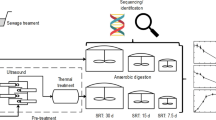Abstract
Composite samples of septage discharging at the Khirbit As-Samra municipal wastewater treatment plant were analyzed during the period from February to the end of October 2007. Septage showed difference in concentrations of pollutants between summer and winter. The average total chemical oxygen demand (COD) of 6,425 mg/L during summer was 2.16 times greater than that in winter, which is 2,969 mg/L. The total biochemical oxygen demand (5 d) represented 45% of total COD in both winter and summer. Anaerobic biodegradability was 75% after 81 d of digestion at 35°C with a biodegradation rate constant (k) of 0.024 d − 1, which was lower compared with 0.103 d − 1 calculated for wastewater with domestic origin in Jordan. Aerobic biodegradability for septage was 48%—COD basis—after 7 d of digestion at 35°C. The lower anaerobic biodegradation rate of septage compared with that of raw wastewater of domestic origin suggested that septage could have a negative effect on the performance of a domestic wastewater treatment plant if septage discharges are not taken into account in the original design of the treatment plant.
Similar content being viewed by others
References
APHA (1995). Standard methods for the examination of water and wastewater (19th ed.). Washington, DC: American Public Health Association.
Boot, N. L. D., & Scott, R. E. (2008). Faecal sludge in Accra, Ghana: Problems of urban provision. In Proceedings to International IWA conference on sanitation challenge: New sanitation concepts and models of governance (pp. 175–184). Wageningen, May 19–21, 2008. Pat 1—oral presentations.
Borboudaki, K. E., Paranychianakis, N. V., & Tsagarakis, K. P. (2005). Integrated wastewater management reporting at tourist areas for recycling purposes, including the case study of Hersonissos, Greece. Environmental Management, 36(4), 610–623.
Crites, R., & Tchobanoglous, G. (1998). Small and decentralized wastewater management systems (1st ed.). McGraw-Hill Series in Water Resources and Environmental Engineering.
Fernandes, A. M., Kirshen, P., & Vogel, R. M. (2008). Optimal siting of regional fecal sludge treatment facilities: St. Elizabeth, Jamaica. Journal of Water Resources Planning and Management, 134(1), 55–63.
Halalsheh, M. (2002). Anaerobic pre-treatment of strong sewage. A proper solution for Jordan. Ph.D. Thesis. Wageningen University, Wageningen, The Netherlands.
Halalsheh, M., Smit, T., Kerstens, S., Tissingh, J., Zeeman, G., & Fayyad, M., et al. (2004). Anaerobic biodegradation of sewage in Jordan. In Proceedings to the 10th World Congress on anaerobic digestion (pp. 1450–1453). Montreal, Canada.
Koottatep, T., Surinkul, N., Polprasert, C., Kamal, A. S. M., Kone, D., Montangero, A., et al. (2005). Treatment of septage in constructed wetlands in tropical climate: Lessons learnt from seven years of operation. Water Science and Technology, 51(9), 119–126.
Lin, C., & Chou, J. (1998). Aerobic digestion of septage. Bioresource Technology, 64, 219–224.
Mahmoud, N. (2002). Anaerobic pre-treatment of sewage under low temperature (15°C) conditions in an integrated UASB-Digester system. Ph.D. thesis, Wageningen University, Wageningen, The Netherlands.
Malkawi, S. (2003). Wastewater management and reuse in Jordan. First regional water reuse conference. December 7–9, 2003. Water Authority of Jordan. http://www.mwi.gov.jo/reuse/conferences.html. Accessed on February 10, 2009.
Paing, J., & Voisin, J. (2005). Vertical flow constructed wetlands for municipal wastewater and septage treatment in French rural areas. Water Science and Technology, 51(9), 145–155.
Solomon, C., Casey, P., Mackne, C., Lake, A., et al. (1998). Septage management fact sheet. Technical overview. Project funded by the US Environmental Protection Agency under Assistance Agreement No. CX824652.
Strauss, M., Larmie, S. A., Heinss, U. (1997). Treatment of sludges from on-site sanitation—low-cost options. Water Science and Technology, 35(6), 129–136.
Tchobanoglous, G., Burton, F. L., Stensel, H. D., et al. (2003). Wastewater engineering. Treatment and reuse (4th ed.). Metcalf and Eddy, Inc. Published by McGraw-Hill, New York.
Valencia, R., den Hamer, D., Komboi, J., Lubberding, H. J., Gijzen, H. J. (2009). Alternative treatment for septic tank sludge: Co-digestion with municipal solid waste in bioreactor landfill simulators. Journal of Environmental Management, 90, 940–945.
Van Lier, J. B. (1995). Thermophilic anaerobic wastewater treatment, temperature aspects and process stability. Ph.D. thesis, Department of Environmental Technology, Wageningen Univeristy, The Netherlands.
WAJ (2006). Water authority of Jordan. Annual report.
Author information
Authors and Affiliations
Corresponding author
Rights and permissions
About this article
Cite this article
Halalsheh, M.M., Noaimat, H., Yazajeen, H. et al. Biodegradation and seasonal variations in septage characteristics. Environ Monit Assess 172, 419–426 (2011). https://doi.org/10.1007/s10661-010-1344-4
Received:
Accepted:
Published:
Issue Date:
DOI: https://doi.org/10.1007/s10661-010-1344-4




